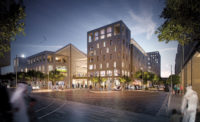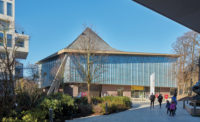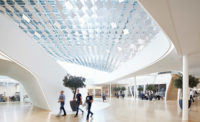At the new London headquarters of security company Banham, architect Allies and Morrison has juggled the demands of a constrained site, a tight schedule, and a complex program, but the pieces have fallen into place with satisfying precision, like the tumblers of a well-engineered lock.
Additional Content:
Jump to credits & specifications
As a repository for customers’ keys and alarm codes, the building is well protected but not defensive in appearance. Its triangular site, bounded by a river and a railway embankment, sits within a small enclave of light-industrial buildings, and its form responds to both the topography and the architectural context while efficiently organizing a diverse range of activities. The ground floor houses a product-display space and workshops for the manufacture of locks. Above, the building rises in two splayed wings containing offices and an “Alarm Receiving Center” (ARC). In this fortified room, operatives monitor CCTV cameras installed at clients’ properties and respond to intruder and fire alarms—a 24/7 operation that requires adjacent staff bedrooms. Additional facilities include inventory storage, a café, and a training academy for apprentice locksmiths.
Brick facades and zinc-clad pitched roofs lend a calm coherence to this mix, and have a suitably industrial character. This choice was also driven by the architects’ extensive experience with the materials, which allowed for the rapid development of the design. The need for speed was imposed by the city’s decision to place a subway station on the site of Banham’s former office, giving it two years to relocate. Banham had previously worked with Allies and Morrison on its own plans to redevelop that site, and the firm’s familiarity with its operation saved valuable time—as did the client’s openness to ideas. “We weren’t fighting against people’s preconceptions,” says Allies and Morrison partner Robert Maxwell. “They trusted us to deliver the best building we could.”
Early meetings were held at Allies and Morrison’s purposebuilt studio, where the architects could point to features that had proved successful. Among those reproduced in Banham’s building are a south-facing roof terrace and a long cafeteria table, where staff from different parts of the business might meet. “We talked a lot about the importance for any business of breaking down silos,” says Maxwell.
With many major decisions made quickly, the architects could devote time to important details. For example, industry standards demand that facilities such as the ARC are windowless, but the architects felt strongly that a window was important for both staff well-being and the building’s outward expression. Their tenacity secured permission to incorporate a double-layered window with blast- and bulletproof glass in an anteroom visible from the ARC. “The feedback is that it’s much appreciated,” says Maxwell.
Other custom features go beyond the requirements of the client’s initial brief to add commercial value. At the company’s previous office, also adjacent to a busy commuter rail line, illuminated signage facing the trains had prompted a useful stream of business leads, and was therefore recreated in the new building. The building, too, provides a working demonstration of Banham’s products, with security features incorporated unobtrusively throughout. Maintaining a relaxed, domestic quality in the interiors was an important counterbalance, showing customers that protection need not compromise the comfort of their own homes.
As a 90-year-old family-run business, Banham is proud of being “unusual in this age of large, impersonal conglomerates,” and Allies and Morrison has worked to weave its heritage and ethos into the fabric of the building. Wayfinding signage and artworks designed by the architects draw on Banham’s graphic archive, and the company’s mark is stamped on the exterior, where its name is picked out in different-colored brick on two gables. Forming the lettering in bricks rather than paint was architecturally labor-intensive but symbolically important: it is a signal that in its new building Banham has not simply developed office space, but found a home.
Back to Good Design Is Good Business 2017
CreditsArchitect: Allies and Morrison — Anja Bradley, Federico Palazuelos Botella, Mark Ellison, Kenny Fitzmaurice, Alex Ford, Helena Gomes, Miranda Li, Robert Maxwell, John Milligan, Sarah Sperber, Eleni Stylianidou, Ruth Treacher, design team
Engineers: Davies Maguire + Whitby (structural); Max Fordham (services/acoustical)
Consultants Moulton Taggart (cost); The Fire Surgery (fire); Sinclair Knight Merz (traffic)
General contractor: McLaren Construction
|
SpecificationsBrick FreshField Lane Roof VM Zinc; Alumasc; Sika Windows Schüco; Vitral Flooring Desso (carpet); Altro (vinyl); WB Simpson (limestone) Glazed Walls Optima Systems Lighting Delta Light; Erco; Trilux; Selux; Philip Payne; DesignPlan; iGuzzini; Foscarini; Astro |

















Post a comment to this article
Report Abusive Comment